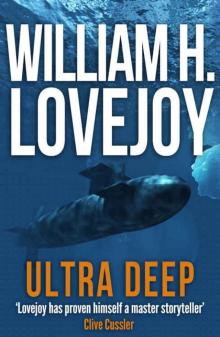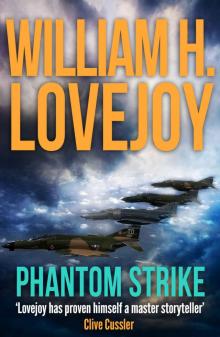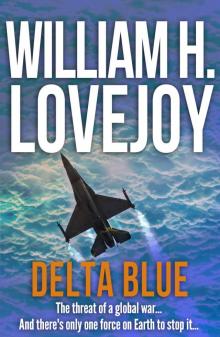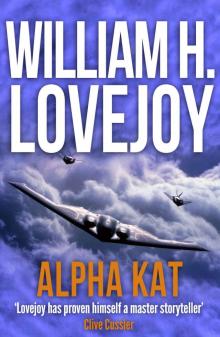- Home
- William H. Lovejoy
Phantom Strike
Phantom Strike Read online
PHANTOM STRIKE
WILLIAM H. LOVEJOY
Copyright © William H. Lovejoy 1993
The right of [author] to be identified as the author of this work has been asserted by him in accordance with the Copyright, Designs and Patents Act, 1988.
First published in 1993 by Zebra Books.
This edition published in 2015 by Endeavour Press Ltd.
DEDICATION
The State of Nebraska does have some positive traits, and the most positive is its people.
This novel is dedicated to some extremely nice and talented Nebraska people: Doug Bereuter, Rich Bringelson, Anne Campbell, Chris Christofferson, Bill Colwell, Jim Exon, Roger Flanders, Dorset Graves, Chuck Harrington, Murl Mauser, Ed Nelson, Ward Reesman, Larry Tangeman, Gerry Vasholz, Dave Wagaman, Bob Walker, Jerry Warner
And in memoriam, Henry Ley and George Rebensdorf.
I consider myself fortunate to have been associated with, and to learn from, all of them at one period in my life.
Table of Contents
One
Two
Three
Four
Five
Six
Seven
Eight
Nine
Ten
Eleven
Twelve
Thirteen
Fourteen
Fifteen
Sixteen
Seventeen
Eighteen
Nineteen
Twenty
Twenty-one
Resurrection
One
From a half-mile away, the birds still looked proud, sleek, and capable. The mid-morning Arizona sun glanced white-hot off shiny aluminium and titanium panels and stabbed the eyes of observers. Wavery heat made the earth quiver in the far distance.
In the lead Jeep, Andy Wyatt backhanded the sweat from his forehead and fished his sunglasses from the breast pocket of his tan, knit sport shirt. The Polaroids killed the glare and gave him a more dismal view.
As they approached the first group of aircraft, Air Force Captain Owen Dinning, who was driving, slowed the Jeep to thirty miles an hour. Dinning was a fair-haired, smiley young man who displayed easy deference to his visitors. In the real, non-military world, he would have a business address on Madison Avenue. He was following one of the asphalt roads that crisscrossed the aircraft park and delineated half-mile-long checkerboard squares. Within the squares, the sagebrush and weeds had been killed off with some defoliant, leaving sun-baked soil that was the colour of spilled tea.
Behind them, a flight of F-15s took off from the air base with a roar that rumbled forever across the flat desert. Wyatt’s eyes followed the two fighters as they banked away toward the Saguaro National Monument, then nosed upward and climbed steeply to the north.
Live airplanes interested Andy Wyatt far more than did dead ones.
He gazed solemnly at the aircraft they were passing. They appeared frozen to the earth, and he was certain that many of them should have been entombed.
The amiable Captain Dinning flipped a thumb at the behemoths broiling in the sun on their left. “Sure you don’t want a BUFF, Mr. Wyatt?”
BUFF. Big, Ugly, Fat Fucker. The scourge of Hanoi. In the course of the war games in Southeast Asia, the B-52s had dropped more ordnance tonnage on North Vietnam than was expended in all of World War II. The daily pounding of the capital city was enough to drive any nation into mania and submission, but something was wrong with the strategy.
Hanoi won.
Viewed from up close, these B-52s saddened Wyatt. There were over a hundred of them parked in long rows. They were forlorn and neglected. Paint and insignia were peeling; metal skin was tarnished; tires were flattened; control surfaces were missing; Plexiglas was grazed and cracked. Most of them had empty engine nacelles, their turbojets scavenged for other uses. He knew that most of them would have had their radar and avionics stripped out. Stacks of debris — drop tanks, pylons, access panels — littered the ground beneath the wings. In the second row over, a blue pickup was parked in the shade of one of the giant swept wings, and two technicians were busy performing a surgical removal of something somebody somewhere needed on one of the forty-year-old bombers.
The design was forty years old, but the B-52 was still one of the mainstays of the Air Force, with 165 G- and H-model aircraft in active service. It said something subtle but powerful about the design.
“I think I’ll pass,” Wyatt told his driver.
“You don’t look too happy, sir.”
“If I were running this air force, I’d strip the damned things, then melt them down.”
“Maybe we’ll need them again?” the captain suggested.
“It’d cost more to rebuild one today than Boeing billed the taxpayer originally, Captain.”
“That’s true, sir.”
Andrew Wyatt did not like viewing the mothball fleet at Davis-Monthan Air Force Base. Supposedly, the thousands of aircraft were being held in reserve, but realistically, most would never fly again. The skeletons neatly scattered over this sandy acreage were a highly visible tribute to obsolescence, an expensive symbol of American waste, Air Force style.
Dinning slowed, downshifted, and spun the wheel to the right at the next intersection. They passed ghettos of Lockheed C-121 Constellations, P-2 Neptunes, a few Electras, some Martin B-57 Night Intruders, Grumman Albatross amphibians, and F-101 Super Sabres. On a faraway plot, Wyatt saw a few golden oldies: B-17s, B-36s, a crippled Mustang.
Wyatt looked behind him. The other Jeep was keeping pace. Bucky Barr waved at him, his big, horsey teeth revealing his glee. Barr got a kick out of almost anything, but his exuberance did not pass to Wyatt. It was not only this traipse through avian tombstones that depressed him. The coming weeks carried the very real possibility that he would be buying memorial markers for some people he liked.
Captain Dinning dropped to second gear, bounced off the hard surface of the asphalt, and raced between the first two rows of what had to be over two hundred F-4 Phantoms. The second Jeep pulled up alongside them, to get out of the mini-cloud of dust Dinning raised.
Wyatt’s guide found his clipboard in the space between the seats, checked the top sheet, and began to scan the tail numbers of the fighters. Halfway down the first row, he braked to a stop, and the tech sergeant driving the other vehicle skidded to a stop next to them.
“Here’s the first one, Mr. Cowan.”
“E model?” Wyatt asked, responding to the name he was using.
“Yes, sir. One of the dozen we’ve got. Most of the retirements here are B, C, and D models. Anything later is still in service, usually with the air reserves. A lot of them, all models, have been sold to friendly governments.”
Wyatt swung his legs out of the footwell and stood up. The desert dust immediately coated the spit-shine of his Wellington boots. His chino slacks had had a crease in them at seven o’clock when he pulled them on in his motel room, but the crease was blurred now by heat and perspiration. His shirt felt sticky. Wyatt had big, muscled shoulders and arms, and the damp shirt acted as if it were part of his skin, another dermal layer.
Barr, Demion, and Kriswell slipped out of the other Jeep, and joined him in front of the Phantom’s snout. They were dressed casually also, fighting the dry heat with jeans, sport shirts, and running shoes. The tech sergeant was in wilted fatigues, and Dinning, in summer Class As, was the only one who appeared fresh. In his Air Force days, Wyatt had known commanders like Dinning, who seemed immune to the elements.
The six of them stood there silently for a moment and looked at the airplane.
“I don’t see any dents,” Bucky Barr noted.
“Maybe they used bondo on it?” Jim Demion said.
“
Whatever they used, it’s still pretty,” Kriswell told them.
Despite the technological advances made with Eagles, Tomcats, and Hornets, the F-4 was still a lethal-looking airplane. It was also a reliable craft, Wyatt knew. Over five thousand had been built, one of the highest production records ever for a fighter aircraft. Only the MiG-21 could boast the same numbers. The Phantom first flew in 1958, and its combat record in Vietnam, flown by the Air Force, the Navy, and the Marines, was commendable.
The huge, ovoid air intakes on each side of the fuselage gave the craft added mass from the head-on view. The outer wing panels were canted upward in a dihedral angle, a counterpoint to the steep, twenty-three-degree anhedral droop of the rear tailplanes. This Phantom was missing its external fuel tanks, and the two wing-mounted weapons pylons which normally sprouted four Sidewinder missiles were bare, The underside was finished in dull white paint, and the fuselage and top surfaces were coated in the most recent scheme of matte olive, green, and tan camouflage colours. The ID was for the 32nd Tactical Fighter Squadron which, as far as Wyatt knew, was still operating out of Europe.
“Want to kick the tires, Mr. B?” Wyatt asked, being careful to avoid true names, deceiving his country, and as far as that went, his air force.
Barr grinned at him. “Hell, yes. I’m a tire-kicker from way back. Salesmen hate me.”
“That’s because you flatten the tires when you kick them,” Kriswell said.
Nelson Buckingham Barr, III, was a solid chunk of a man, his physique akin to that of many boulders Wyatt had seen alongside Rocky Mountain highways. It had always seemed to Wyatt that someone had invented a giant shoehorn solely for the purpose of wedging Barr into fighter cockpits. He was five-feet, nine-inches tall, but his breadth gave him solidity.
Tom Kriswell, the electronics engineer/magician, was a foot taller than Barr and half as wide. He spoke to Dinning. “When was it brought in, Captain?”
Dinning checked his clipboard. “Three months ago, on April seventh.”
“Flown in? Not transported?”
“Under her own power, sir.”
“Suppose it’s still got electrical power?”
“If they haven’t pulled the batteries yet, we can give it a try,” Dinning told him.
Dinning, Kriswell, and Jim Demion, Wyatt’s aeronautical engineer, approached the side of the plane. Kriswell found the recessed control for the forward canopy and played with it. With a reluctant slurp of the rubber seals, the canopy began to raise. It was a slow process, attesting to the depleted condition of the batteries.
The tech sergeant got a ladder from the back of Dinning’s Jeep, brought it over, and hooked it over the cockpit coaming. Kriswell scampered up the rungs with agility surprising in such a long and lean body, checked the safety pin on the ejection seat, swung his skinny legs inboard, and dropped into the seat.
Jim Demion began a circuit of the aircraft, sticking his head up into landing gear retraction wells, testing control surfaces, peering up the tail pipes of the twin J79-GE-17 turbojets. He popped the Dzus fasteners on access hatches, swung them open, and poked around in the innards. He came around to the front of the airplane and removed the protective covers on the air intakes.
Bucky Barr kicked the port side tire.
Kriswell tossed Wyatt the aircraft maintenance log, which had been stored in the cockpit.
“What have you got up there, Tom?” Wyatt asked.
“Not much. I’ve got power on the instrument panel, but not enough amperage to check radios or radar.”
Wyatt took the log back to the Jeep. He sat on the passenger’s seat and slowly read through it, making his own notes in the black leather notebook he carried in his hip pocket. This Phantom had been built in 1975 and had therefore missed the Vietnam festivities. The airframe had over forty thousand hours on it, but both of the General Electric turbojets had been changed out and now had eleven thousand hours on them. They would have to be rebuilt to achieve the reliability he wanted. The craft sported a Tiseo zoom-lens video system which enhanced the pilot’s visual target-tracking. None of the F-4s featured Head Up Displays, but this machine did have the advanced sight system. It was computer-based and made interception and air or ground weapons delivery more accurate. The newer APQ-120 fire control radar was installed, as well as the additional fuel cell in the rear fuselage. That gave it a sixteen-hundred-mile ferry range.
Jim Demion sauntered back to the Jeep and waited for his turn at the log.
Their inspection took forty minutes.
When they were done, standing in a half-circle around the forlorn airplane, Wyatt asked, “Anybody have questions for the captain?”
There were none, but then the captain was not an airman, anyway.
“Okay,” Wyatt said, “let’s take a look at the next one, Captain Dinning.”
At the next Phantom, Wyatt pulled Demion aside, out of earshot of Dinning and the tech sergeant. “What do you think, Jim? Are these old bastards going to work for us?”
“It’s the best thing we’ve got going, Andy.”
“That doesn’t answer the question. We’re going up against damned sophisticated weapons systems. I don’t want bodies all over the landscape when it’s over.”
“We talking our bodies?”
“They’re the ones uppermost in my mind, Jim.”
“Go back to what we talked about before, Andy. The opposition’s systems may be state-of-the-art, but keep telling yourself about the people behind them. They’re assholes, remember?”
“Maybe. But assholes are conditioned to react instinctively.”
“Just be cool, boss. When Kriswell and I are done, those aero-fucking-planes will be things of beauty. Venus de Milo, step aside.”
“I don’t give a good goddamn what they look like,” Wyatt told him.
“But Bucky does,” Kriswell said.
Barr had demanded, and received, responsibility for cosmetic changes. It would, he said, keep him out of the innards where he was all thumbs, anyway.
In four hours, the team looked over the three F-4Es, four F-4Ds, and one C model. By one o’clock, the sun was delivering temperatures above one hundred degrees, and probably much more than that on the barren surfaces of Davis-Monthan Air Force Base’s “Boneyard.”
“I’m hungry,” Barr said.
“That doesn’t tell us anything,” Kriswell said. “You’re always hungry.”
“I’m tired of kicking tires. Let’s play airplane tomorrow, and go back to the motel now.”
“If you start walking now,” Wyatt grinned at him, “you’ll make Tucson by the time we’re done.”
“Shit. How come I always get hooked up with a bunch of workaholics?”
“Do you want to see a couple more, Mr. Cowan?” Dinning asked.
“We’re about Phantomed out, I think. Let’s look at that 130F now.”
They all got back in the blue Air Force Jeeps and drove about three miles to where a C-130 Hercules was parked. The Lockheed C-130 transports, born in 1951, were operational airplanes still in production and utilized globally by a dozen governments and some private enterprises. It was a competent workhorse, and Wyatt already owned one that he had committed to this project.
This single Hercules condemned to mothballs was a one of a kind, designated a KC-130F. It had been an experiment in converting the Hercules to the role of aerial tanker in the normal, designated way of military contracts and design, though Wyatt had heard stories about jury-rigged C-130 tankers created on the spot in Vietnam. By the Marines, probably, since they were expert at Rube Goldberg devices. Apparently, the Air Force had decided to stick with their larger, jet-engined tankers because this aircraft log showed very little time on the four Allison turboprops. After a short reconnaissance trip around, and inside, the aircraft, both Demion and Kriswell appeared satisfied.
Back on the main grounds of the base at three o’clock, Captain Dinning lost the tech sergeant and took them into the officer’s club for a sandwich and a beer.<
br />
“Jesus! Air-conditioning. I’d forgotten what it was like.” Barr picked at his yellow Izod shirt with thumb and forefingers like a dainty dilettante, tugging it away from a chest as hairy as a brown bear’s. He took off his Pebble Beach golf cap and wrung it out.
“Your upbringing left something to be desired,” Demion told him.
“Like what?”
“Like upbringing.”
“I was a deprived youth,” Barr explained.
Barr was one of three sons of a noted and Mayflower-linked New Hampshire family. Lacking one physical trait that identified him with the Barr clan, he had evolved as the black sheep. While he had a Yale education, Bucky Barr took delight in being good-naturedly boorish. He also had a multimillion dollar trust fund that paid him a quarter-million dollars every January 2.
They pushed two tables together to give themselves some elbow room and spent an hour with French fries, hamburgers, Heineken, and their respective notes. The debate involved the perceived condition of subsystems, mostly.
Captain Dinning kept the coffee cups filled and the beer cans rolling, and listened to them with what Wyatt thought was growing suspicion. The captain appeared to have a growing distrust of their apparent cover story, which had not been fully detailed for him. Wyatt did not worry too much about their guide, but from time to time, he threw in a statement intended to support the cover. “On 3387, what’s the result if we re-rivet with the new countersunk rivets?”
Demion said, “Much cleaner. It’s worth maybe point-one Mach.”
At four o’clock, the four of them agreed on a list, and Wyatt jotted down the tail numbers. At the bottom of the page, he wrote in a phone number with a 202 area code. He ripped the page out of his notebook and handed it to Dinning.
“That’s the roster, Captain, providing, of course, that each of them still carries an airworthiness certificate.” The captain, who was a public relations specialist rather than a pilot, looked over the list carefully. “I’ll double-check the certificates for you and get the paperwork started, Mr. Cowan.”

 Ultra Deep
Ultra Deep Phantom Strike
Phantom Strike Delta Blue
Delta Blue Alpha Kat
Alpha Kat Seaghost
Seaghost